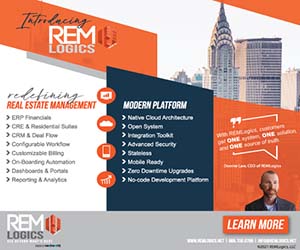Overcoming Office Uncertainty with Digital Amenities and Agile Workspaces

The challenge: adapting to changing office needs among uncertainty
At the beginning of 2021, the return to the office seemed in sight. Vaccines rolled out, and companies made plans to bring workers back by fall. However, the latest surge in cases made companies rethink their plans from the start of the year Ė increasing uncertainty for occupiers and owners.
On top of the current uncertainty around the return to work, thereís also uncertainty surrounding how people will return to the office.
Mass remote work has seismically shifted how companies envision the future office. 75% of surveyed companies donít expect to have one main work location in the long term. In addition, only 13% of surveyed companies expect to bring their employees back to the office full time. When everyone returns to the office, most companies expect it to be a hybrid model.
However, three out of five surveyed companies donít have a plan in place for returning to the office. Why? Because companies are uncertain of what their needs will be when they return. Without a clear vision of the future, companies are stalled in making plans for the return to work.
For office owners and operators, this uncertainty presents an opportunity for differentiation. Digital amenities and agile workspaces enable quick space shifts to meet occupier needs as they change. This means companies can return to the office amid uncertainty, with the confidence that their building can change as their needs evolve.
Digital amenities for a modern tenant experience
Many building owners are adding amenities to incentivize tenants to return to the office. While tenants still want traditional amenities like gyms, these amenities arenít at the forefront of their minds.
Instead, tenants are grappling with what returning to the office looks like. They need amenities that create a seamless transition from working at home to working in the office. Tenants also need amenities that connect the digital experience to their physical spaces.
Digital amenities (like fiber internet, cyber security, and unified communications) provide the tools tenants need to create a hybrid work model. Whether employees are in the office or working remotely, digital amenities connect every employee to create a cohesive workflow for tenants.
Beyond digital amenities that connect, tenants also need digital amenities that provide scene intelligence. Scene intelligence allows tenants to track occupancy, book shared amenities, monitor their air and environment, and more. This scene intelligence enables tenants to better understand their space and identify and adapt to changing needs.
Digital amenities enable occupiers to navigate the uncertainty of office needs. This capability is crucial to attracting tenants back to office buildings.
Agile workspaces for constant improvement
Along with digital amenities, navigating the current office uncertainty also requires agile adjustments.
10-year leases used to be the norm. Owners leased office space to tenants and, for the most part, the space stayed the same for the duration of the lease. Until it was time to renew the lease, owners didnít have to worry about improving building spaces.
However, even before the pandemic, lease duration was changing. Companies no longer wanted to be locked into a lengthy lease. They, instead, wanted flexibility to change spaces as their needs changed. Short leases and flexible spaces became increasingly popular. Occupiers who constantly improved were better able to attract top tenants.
The pandemic accelerated this trend. Mass remote work and company closures only highlighted the need for office space flexibility and agility.
Because of these changes, itís no longer enough to offer a great space and amenities. Owners need to make agile adjustments. By measuring how spaces are doing and getting feedback on spaces and amenities, owners can make adjustments to meet changing tenant needs. Owners need to be constantly improving to adapt to shifting tenant needs and to attract and retain top tenants.
Embrace change with digital amenities and agile workspaces
The return to work is uncertain for owners and occupiers. What is certain? Occupier needs have dramatically changed as a result of the pandemic. Most companies wonít need as much space as they did before. In addition, companies will likely use their space differently than they used to. Hybrid work has shifted offices from a place to get work done to a place to collaborate and build company culture.
These changes and widespread uncertainty mean owners need to adapt to attract and retain tenants. Simply offering more amenities isnít enough to thrive.
Instead, owners need to offer digital amenities that make hybrid work seamless. However, offering digital amenities is only part of the solution. Owners also need to use digital amenities to create a feedback loop that enables agile adjustments and constant improvements. With these continuous adaptations and improvements, owners can create buildings that appeal to tenants even amid uncertainty Ė which is key to success for office buildings during and after the pandemic.
This Week’s Sponsor
Yardiģ develops and supports industry-leading investment and property management software for all types and sizes of real estate companies. Established in 1984, Yardi is based in Santa Barbara, Calif., and serves clients worldwide. For more information on how Yardi is Energized for Tomorrow, visit yardi.com.
Read Next
 5/15/2025
5/15/2025
Tech, Talent and Transformation: 2025 Digie Finalists Announced For 27 years, Realcomm has presented the Digie Awards to acknowledge companies, real estate projects, technologies, and individuals that have advanced the commercial real estate industry through the strategic use of technology, automation, and innovation.
 5/15/2025
5/15/2025
Empowering Space Management with Data-Driven Visualization For effective CRE space management, itís critical to centralize lease data, maximize rental square footage (RSF), improve energy efficiency and reconfigure spaces to meet changing needs.
 5/8/2025
5/8/2025
The AI-Powered Workplace Evolution: Redefining the Business Landscape In today's rapidly evolving business environment, the fusion of Artificial Intelligence (AI) and Workplace Management is revolutionizing the way organizations approach workspace optimization and operational efficiency.
 3/27/2025
3/27/2025
The Convergence of Edge Computing, Cloud, and AI in Building Automation and Smart Buildings In the built environment, we have seen the convergence of Operational Technology (OT) and Information Technology (IT), later expanding to include Workplace Technologies (WP).







%20(1)%20(1)%20(1).png)







